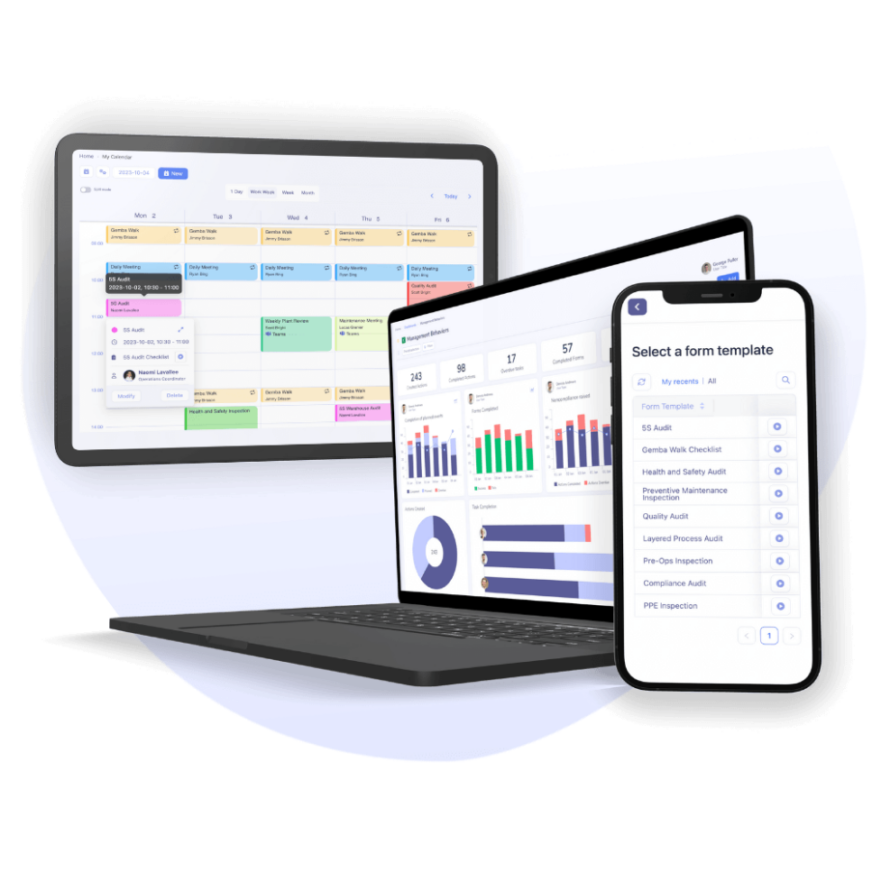Which Type of Organization?
Gemba Walks are a common practice on the production floor in the manufacturing industry. Performed regularly, Gemba Walks are an essential part of operational control and support a strong continuous improvement culture.
Ultimately, Gemba Walks are useful for all organizations with the need to detect issues and generate improvement ideas proactively.
Download our eBook: Step by step guide to implement Gemba Walks
Which Management Level?
Our answer: all levels of management should perform Gemba Walks in accordance with their role and responsibilities. That way, managers can take the pulse on the floor and ensure that everything is going according to plan.
- Team leader, supervisor
- Manager, department or service director
- Director, President, VP, C-Levels
Going on the factory floor through Gemba Walks is a high-value practice for every level of management.
Martin Lauzon, Project Director at Tervene
& former Operations Director

3 Differences in Managers’ Gemba Execution
All management levels can benefit from Gemba Walks. Nonetheless, we specify three aspects of Gemba Walks’ execution that are different from a management level to another.
- Validation points (checklist)
- Type of action taken
- Gemba Walks frequency
Difference #1: Validation Points (Checklist)
The main idea of a Gemba Walk is to ensure a systematic presence of all levels of management on the floor. That being said, Gemba checklists need to contain validation points in accordance with the role executing it. For example, a production supervisor should not validate the same elements as a director or a vice-president.
Difference #2: Type of Action Taken
A supervisor should take action to solve what concerns daily operations, while a director takes action on issues at the process level. A high-level manager will take a more general look over every department or plant and should take action to improve his whole management system.
Difference #3: Gemba Walks Frequency
Different management levels should focus on different time frames.
Thus, the standard Gemba Walk schedule should vary according to the level of management. Supervisors should execute Gemba Walks daily, several times a day. The head of a department or the director can do Gemba once a week. Finally, a president or vice-president could execute a Gemba Walk once a month.
Collaboration Between Levels of Management
Transfer of Issues
The first person to detect an issue or an improvement opportunity is not always the one who should act on it. The organization should have an ecosystem of collaboration to solve problems efficiently. It is essential to have the ability to transfer the responsibility to the right person and to transfer it to a higher level of management if needed.
Context: A supervisor does not always have the time or authority to address a problem. They must be able to transfer responsibility to a higher level or a support group. If a director encounters an issue during his Gemba Walk that requires being taken care of by his team, he must transfer it.
Meeting Objectives
Production meetings, daily huddles, or daily management meetings – no matter what we call them, these moments play an important role in the transfer of issues. They help create a moment to discuss an issue detected with Gemba Walks and provide a moment to transfer that issue to the right person or resource.
Accountability of all Levels of Management
One of the challenges of operational control is to maintain a strong culture of accountability and ownership at every level of management. Frequently validating checklists increases managers’ responsibility and promotes adherence to operational control.
Tervene – Gemba walk App
Tervene develops a Gemba Walk app connected with a problem-solving ecosystem and a continuous improvement tool, making it easier for managers to address every issue efficiently. Also, high-level managers get real-time visibility over Gemba Walks’ execution and quality.

Useful resources
Blog post: What is a Gemba Walk?
Blog post: Essential Features of a Gemba Walk App
Blog post: Gemba Walk Checklist and Questions
























